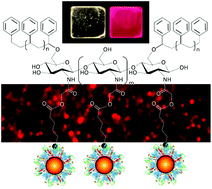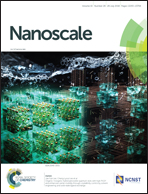Quantum dot–polymer conjugates for stable luminescent displays†
Abstract
The broad absorption of light in the UV-Vis-NIR region and the size-based tunable photoluminescence color of semiconductor quantum dots make these tiny crystals one of the most attractive antennae in solar cells and phosphors in electrooptical devices. One of the primary requirements for such real-world applications of quantum dots is their stable and uniform distribution in optically transparent matrices. In this work, we prepare transparent thin films of polymer–quantum dot conjugates, where CdSe/ZnS quantum dots are uniformly distributed at high densities in a chitosan–polystyrene copolymer (CS-g-PS) matrix. Here, quantum dots in an aqueous solution are conjugated to the copolymer by a phase transfer reaction. With the stable conjugation of quantum dots to the copolymer, we prevent undesired phase separation between the two and aggregation of quantum dots. Furthermore, the conjugate allows us to prepare transparent thin films in which quantum dots are uniformly distributed at high densities. The CS-g-PS copolymer helps us in not only preserving the photoluminescence properties of quantum dots in the film but also rendering excellent photostability to quantum dots at the ensemble and single particle levels, making the conjugate a promising material for photoluminescence-based devices.



 Please wait while we load your content...
Please wait while we load your content...